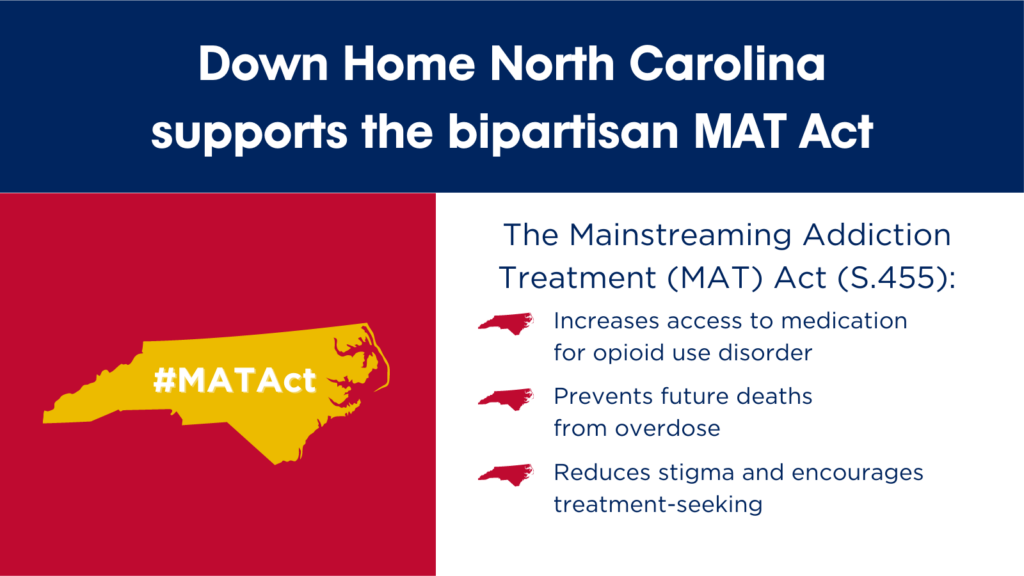On Tuesday, June 28, Down Home North Carolina joined more than 20 North Carolina organizations to issue a coalition letter urging Senators Richard Burr and Thom Tillis to pass the bipartisan Mainstreaming Addiction Treatment (MAT) Act (S.455). If passed, the MAT Act would remove federal barriers to medications for opioid use disorder, increase access to lifesaving treatment for thousands of people with addiction, and reduce stigma.
Down Home members see the devastating impacts of substance use on our communities, families, and friends in rural North Carolina. We love our people and communities and we are clear eyed when we say: We need support and help.
In 2021, the U.S. saw nearly 108,000 overdose deaths. The overdose crisis has greatly affected North Carolina, which experienced a 16% increase in overdose deaths last year. Overdose deaths are preventable through evidence-based treatment, including medication. By supporting the MAT Act, Senators Burr and Tillis can prevent future deaths and help North Carolinians with substance use disorder find recovery.
The full text of the letter our coalition created can be read below:
June 28, 2022
The Honorable Richard Burr U.S. Senate 217 Russell Senate Office Building Washington, DC 20510 | The Honorable Thom Tillis U.S. Senate 113 Dirksen Senate Office Building Washington, DC 20510 |
RE: The Mainstreaming Addiction Treatment Act (“MAT Act”, H.R. 1384 / S. 445)
Dear Senator Burr and Senator Tillis:
The undersigned North Carolina organizations thank you for working to address the mental health and substance use disorder crisis. As you consider legislation to address this public health emergency, we urge you to pass the Mainstreaming Addiction Treatment Act (“MAT Act”, H.R 1384 / S. 445) to prevent overdoses, increase access to treatment, and reduce stigma.
North Carolina is losing children and parents to drug overdoses at alarming rates. During the COVID-19 pandemic, overdose deaths in North Carolina have increased by 64% (from 2,457 annual deaths in February 2020 to 4,023 annual deaths in December 2021). That loss of life far outpaces the national rise in overdose deaths of 45% over the same period. The vast majority of overdoses involve opioids and, in North Carolina, rates of overdoses are highest in rural areas.[i] Without action, thousands more North Carolina families will suffer the loss of loved one to an overdose. As organizations from across the state, representing and supporting North Carolinians from rural, urban, and suburban regions, we encourage you to support this policy to increase access to life-saving treatment.
To help stem the overdose crisis, the North Carolina Department of Health and Human Services has issued guidance to health care providers to encourage them to prescribe buprenorphine.[ii] Buprenorphine is a lifesaving medication that cuts the risk of overdose death in half and supports long-term recovery. The medication prevents painful withdrawal symptoms and stems opioid cravings. Buprenorphine is a safe and effective medication that has been FDA-approved for opioid use disorder for twenty years and is available in generic. Buprenorphine is considered a gold standard of care for opioid use disorder because it reduces heroin and fentanyl use and helps individuals achieve recovery.[iii]
But due to outdated federal rules that prevent health care providers from prescribing buprenorphine, only about 1 in 10 people with opioid use disorder receive medications for the condition.[iv] A recent HHS report found that three-fifths of North Carolina counties have a high need for opioid use disorder treatment. Despite that need, half of North Carolina counties have low-to-no patient capacity for prescribing buprenorphine. Of significant concern are the nearly one-fifth of North Carolina counties that do not have a single provider who can prescribe buprenorphine for opioid use disorder.[v] This lack of access to buprenorphine is contributing to growing overdose deaths across the state.
The MAT Act will remove the outdated federal rules that prevent health care providers from prescribing buprenorphine for opioid use disorder. The bill will allow all health care providers with a standard controlled medication license to prescribe buprenorphine for opioid use disorder, subject to state licensure requirements. The bill will also expand access to training by launching a national education campaign on best practices for treating substance use disorder. The MAT Act is a common-sense solution to the overdose crisis that will increase treatment choices for North Carolinians.
We urge you to pass the MAT Act to save lives and support healing. With overdose deaths rising at alarming rates in North Carolina, the time to expand access to safe and effective treatment is now. By eliminating federal bureaucracy, the MAT Act will equip states and local governments with a key tool to address the unique treatment needs of their communities. We look forward to working together to pass this common-sense solution that can keep North Carolinians safe.
Thank you for your consideration.
Sincerely,
North Carolina AIDS Action Network
North Carolina Coalition to End Homelessness (NCCEH)
North Carolina Conference of District Attorneys
North Carolina Council of Churches
North Carolina Department of Justice
North Carolina Harm Reduction Coalition
North Carolina Public Health Association
Benevolence Farm
Cumberland County District Attorney’s Office
Down Home North Carolina
ekiM For Change
Families Moving Forward
Fruit of Labor Action Research & Technical Assistance, LLC
Full Circle Recovery Center in Macon County
Guilford County Solution to the Opioid Problem
Holler Harm Reduction
Queen City Harm Reduction
Rowan County United Way
S&H Youth and Adult Services, Inc.
Tia Hart Community Recovery Program
Twin City Harm Reduction Collective
Volunteers of America Chesapeake and Carolinas
Western North Carolina AIDS Project
[i] See Ctrs. for Disease Control and Prevention (“CDC”), Vital Statistics Rapid Release: Provisional Drug Overdose Death Counts (2022); CDC, Urban-Rural Differences in Drug Overdose Death Rates (1999-2019), at 2 (Mar. 2021); Clarissa Donnelly-DeRoven, Gaps in NC addiction treatment disproportionately hit rural residents of color, NC Health News (June 6, 2022).
[ii] North Carolina Dep’t Health and Human Svcs., Treatment of Opioid Use Disorder with Buprenorphine and Buprenorphine/Naloxone (2019).
[iii] See Nat’l Acad. of Sciences, Engineering, and Medicine, Consensus Study Report: Medications for Opioid Use Disorder Save Lives, Nat’l Acad. Press, at 6 (2019).
[iv] Substance Abuse and Mental Health Svcs. Admin., Key Substance Use and Mental Health Indicators in the United States: Results from the 2020 National Survey on Drug Use and Health, at p. 41 (Oct. 2021).
[v] U.S. Dep’t Health and Human Svcs., Geographic Disparities Affect Access to Buprenorphine Services for Opioid Use Disorder, at Report in Brief (Jan. 2020).Down



